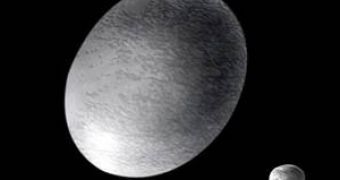Astronomers still have trouble establishing once and for all the number of planets our system is comprised of. The recent conferences were of no help in this regard, as both a clear definition of the term "planet" and a reasonable delimitation line at the end of the planetary system eluded the scientists, while the continuous discovery of small celestial bodies confused them even further.
So far, opinions are divided: some claim that in the end, there can be only eight planets, few believe there are nine, including Pluto, while others state there are definitely thirteen (and counting), based on the continuous discovery of small "plutoids," as they call the dwarf planets floating around in the Kuiper Belt. The Kuiper Belt, the icy rim of the planetary system which is filled with such plutoids (small bodies that show some characteristics common to planets and are located beyond Pluto), will be visited by the New Horizons probe sometime in 2015. It would be good if, by then, clarifications on the term "planet" were concurred upon, as the probe is sure to yield thousands of such small bodies.
Following the lack of consensus at the Great Planetary Debate (an international conference of astronomers on the topic of planet number), IAU (International Astronomical Union) changed its prior definition of planets, which basically called this way anything of Pluto's size or greater (without being a star) that orbits the Sun. The new definition proposed that a planet was "a celestial body orbiting a star or a star remnant that is massive enough to be rounded by its own gravity, is not massive enough to cause thermonuclear fusion, and has cleared its neighboring region of planetesimals" – the term refers to solid objects that are believed to exist in protoplanetary disks (from which planets are formed) and debris disks. Another physical property of a planet is the hydrostatic equilibrium, a phenomenon that occurs when the compression caused by gravity is balanced by a pressure gradient, creating a pressure gradient force in the opposite direction.
But the recent naming of the discovered plutoids (Eris, Ceres, Makemake and the newly-found – Haumea) by the IAU indicates that the institution acknowledges them as planets, since only planets receive names. Haumea (called so after the Hawaiian goddess of childbirth and fertility, whose children sprung from her body) has an oblongated shape like a football (American kind) and is orbited by two moons (viewed and named as the goddess' children), Hi'iaka and Namaka. It looks very different from the bodies commonly accepted as planets, and that is why scientists are still reluctant to labeling it as such.
And more than that, because recent (and future) discoveries constantly yield new planetoids, the uncertainty about how far the solar system stretches and how many members it actually has makes some astronomers (IAU included) divide the solar system into two parts: the planets (the eight bigger ones) in one class, and the plutoids (Pluto and its distant tinier "relatives") in the other. However, some researchers do not agree with this, especially since the second group is the representative part of the planetary spectrum (e.g. they are more numerous) as compared to the eight big ones. As planetary scientist Alan Stern puts it, "It's the most populous class of planets in the solar system. Pluto's no longer the misfit."

 14 DAY TRIAL //
14 DAY TRIAL //